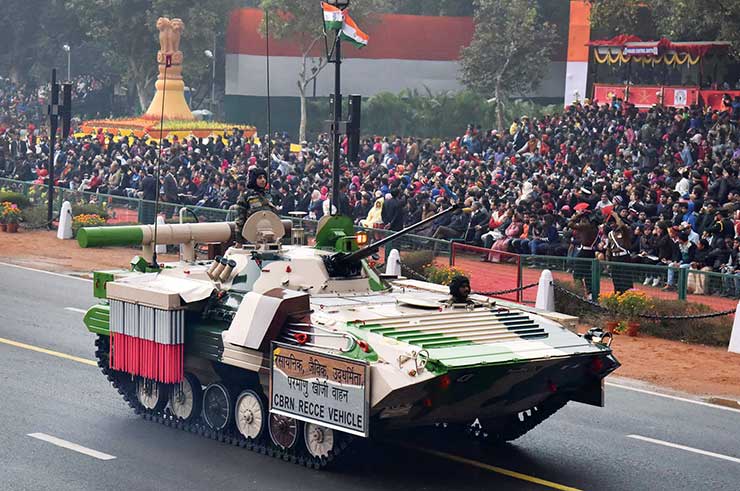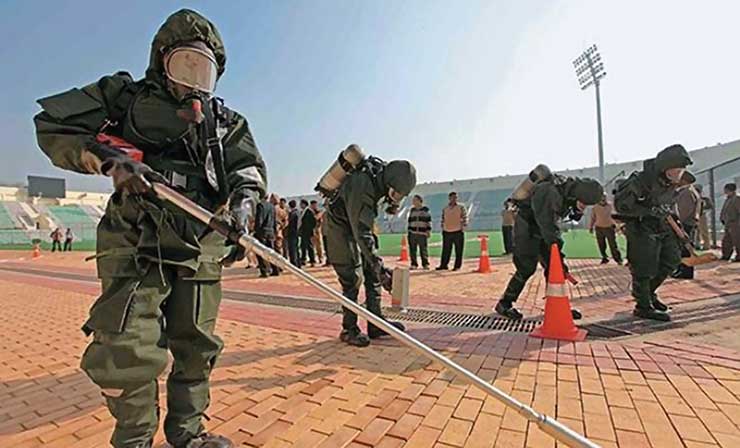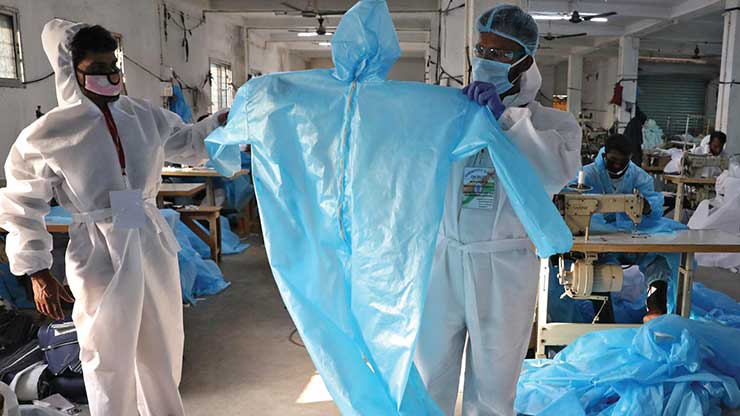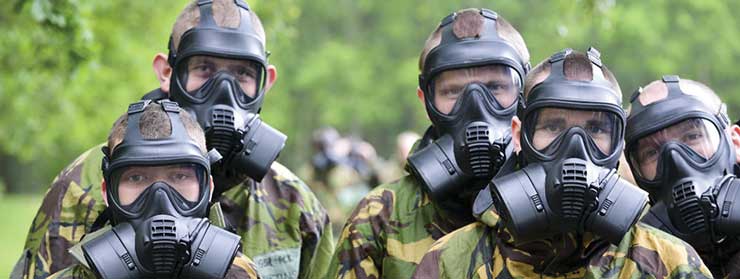
The two-year-long Covid-19 pandemic and the urgent need for testing kits, PPE, masks, sanitisers has led to serious thought about Indian capability to rapidly deploy Chemical, Biological, Radiological and Nuclear (CBRN) equipment across the country. In addition, a rise in levels of civic awareness for protective measures has also created a need to enhance local industry for protective means. Sanitisers have brought the subject of decontamination to the breakfast table. It is the dearth of detection and testing systems for bio-threats that has caught the industry unawares.
In this rise of panic in social and civic awareness, is there a concerted and focussed effort to develop in-house capability in terms of detection, protection, decontamination and medical management of CBRN incidents? Has ‘Make in India’ reached the CBRN frontiers? Defence Expo Feb 2020 saw merely three Indian CBRN participants. What will the scenario be in 2022 and beyond?
Background
The Indian Nuclear Biological and Chemical (NBC) defence programme began in the late eighties as a core training facility at the College of Military Engineering (CME), Pune, in collaboration with the Defence Research and Development Organisation (DRDO). The term NBC was revised to CBRN in view of the emerging Radiological threat. In 2010, the government approved a consolidated CBRN Defence Technology Programme covering 36 key CBRN projects. Today, there are ten laboratories of the DRDO engaged in developing various categories of CBRN equipment based on current and emerging technologies.

Since 2010, the DRDO also started looking at non-military clients (NDRF, SDRF, NSG and other state-level counter-terrorist units) for their CBRN equipment. Detection equipment, forensic capabilities, protective suits, masks and decontamination equipment is also needed by civil-first responders, border/port-control agencies and incident-management agencies.
The Covid-19 crisis has highlighted gross deficiencies in many such systems with these agencies. The CBRN being a sensitive matter, R&D has remained with the DRDO. This led to a lack of competition and technological growth. However, developments in the last few years have led to some positive outcomes. The recent opening of the defence sector to private players and the ‘Make in India’ push by Prime Minister Narendra Modi has led to positive outlooks. Technology transfers and sharing R&D with private players has led to the emergence of the state of the art equipment within the Indian private sector.
Existing Indian CBRN Industry
There are a few Indian firms engaged in the production of high-quality CBRN equipment such as suits, masks and respiratory devices, collective protection shelters, radiological sensors and medical equipment. A lot of expertise (and in a few cases even sound R&D) has been instituted and a stable base is well in place. Most of these industries also have a ToT agreement with the DRDO.
However, the CBRN is a low-demand (less probability of occurrence compared to other crisis situations), low-technology, but high-impact industry. Therefore, any private industry entering the CBRN market needs to have another sustainable business avenue for survival. This has been one of the major factors for the lack of private CBRN industry in India. The second main issue is that there is minimal government support for R&D or assurance of orders of approved and passed products. This also applies to critical hazardous material (Hazmat) equipment in the civil arena like PPE, masks, special detection and testing kits, analysers, mass sanitisers and decontamination equipment.
Notwithstanding the above, there has been a spurt of ‘Covid-19 compliant PPE Manufacturers’ for the last two years. Garment, IT and even plastic industries have begun making PPE. Most of these ‘fly-by-night’ operators are not sustainable in the long run and are trying their luck of a fast buck in a crisis situation. At the same time, there are some startups and diversified industries that have developed excellent equipment and systems mostly with Covid-19 in view. These can be adapted with some modifications to many CBRN threats. These industries need to be encouraged to expand their range of products for wider CBRN threat mitigation.

Avenues for Collaboration
While the subject of CBRN Defence has largely been a closed-door one, a recent change of stand indicates that foreign collaboration for CBRN equipment is feasible. The focus of future R&D, especially by private industry, is required in the following areas:
● Detection Equipment. India has a good Radiological & Nuclear devices (detectors, sensors and survey meters) industry. While a humble start has been made with support from the DRDO, chemical detectors are still imported and we need robust Indian manufacturers. More private involvement is desired. There is an urgent need for the state of the art biological detection equipment for field use for military, paramilitary, civil defence and health services.
● Integrated compact detectors for Drones or UGVs. As the future lies in robotics and automation, there is a need to develop small reliable sensors which can be integrated with drones and Unmanned Ground Vehicles (UGVs).
● Automated CBRN Sentries. These robust stand-alone fixed or robotic devices are conceptualised to have a networked CBRN sensor suite, which can transfer data automatically to an integrated Situation Awareness and Hazard Mapping system for optimal response. Deployed in a grid to give real-time CBRN threat inputs, these are ideal for civilian use (critical infrastructure, municipal or district hazard mapping) or military use in field locations.
● Protection Equipment
Individual Protection Equipment (IPE). Suit technology is changing. CBRN proof and self-decontaminating fabrics with negligible physiological stress are being developed. Masks and breathing apparatus are getting sleeker and lighter with longer operational capabilities. Hazmat suits are mostly imported. These technologies need to be incorporated into Indian products.

Collective Protection. Fixed Underground Fallout shelters are passé. ColPro type flexible, modular, inflatable, quick deploy shelters are becoming the norm. Similarly, containerised CBRN proof shelters with compact CBRN filtration units, integrated detection and hazard mapping systems are also favoured for mechanised operations and deployment by civil agencies and response forces.
Armoured Vehicle and Shipboard Protection. The CBRN protection for armoured vehicles and ships is normally in-built by the manufacturer. Some Indian manufacturers are already producing and integrating the detection, filtration and actuating devices on these platforms. However, the latest advancements and new technologies for enhancing such protection (especially filtration) are always being sought.
● Decontamination Systems. Decontamination is an often-overlooked area. Most of the available equipment is outdated and of obsolete technology. Advancements in self-decontaminating suits and paints, lighter and more effective decontamination systems and greater efficiency decontamination agents are being sought. Sadly, as yet there are no Indian firms engaged in the manufacture of decontamination equipment.
● Medical Management. This is a field where India has made good progress. The DRDO and other agencies have developed excellent drugs, antidotes and casualty-management apparatus. There is still a need for better drugs, vaccines, antidotes, advanced triage kits and casualty-management equipment. Casualty isolation pods and CBRN/Isolation ambulances are areas of interest.
● CBRN Software. Hazard mapping, situational awareness and decision support are critical areas of CBRN incident management. Already the world is looking for use of AI and robotics-based systems to aid these areas. India has great potential for developing such software systems. Already some private players are working on Integrated CBRN Control systems that can be effectively used.
● Research. There is a huge scope for growth of private R&D. This will help in developing the state of art equipment, enhance healthy competition and garner greater synergy between DRDO/CSIR and private vendors for enhanced technological advancement.
● Training & Simulation. The Armed Forces have a very advanced training protocol for CBRN Training. Civil Defence and Private CBRN response training have yet to take off in India. Some other areas of interest are automated training aids and simulators based on in-service equipment.

● Testing Facilities. While testing facilities for various CBRN equipment exist with DRDO/CSIR, there is a dire need to upgrade these. Approved private testing facilities are few. Internationally-acclaimed and accredited research laboratories, in partnership with Indian companies, can engage the DGQA and DRDO for setting up the state of the art testing facilities.
● The Emergency Management Market. The Emergency Management market in India is huge and just beginning to show its head. The Indian government has instituted a string of measures to promote these. However, execution demands adequate training and capacity building. The foreign CBRN Industry (especially Europe, USA and Israel) have a lot to offer in these areas, and there is no dearth of Indian clients (governmental, quasi-governmental and private).
Conclusion
The need for the Indian CBRN industry has already begun to be felt by government agencies and the Armed Forces. A great avenue of CBRN equipment usage is the civil Emergency Management apparatus. Covid-19 has shocked us all with the emergent need for testing and protective equipment in huge quantities. Rising terrorist incidents and frequent industrial accidents are already making the authorities think of CBRN Incident Management. It is time India takes note and encourages CBRN industry growth for optimal national security.
–The author is a veteran tankman and a CBRN Security professional has been a Key Adviser to the Government of India on National CBRN Security. He has also served as a Key CBRN Expert for the EU CBRN Risk Mitigation Centres of Excellence initiative for the Eastern and Central Africa region. A Visiting/adjunct Faculty at select universities, prolific writer and a CBRN subject speaker in international seminars and conferences, he holds a PhD in CBRN Counter Terrorism. Presently he is a freelance CBRN Security and Risk Mitigation Professor, and Consultant based at Pune, Indi.. The views expressed are personal and do not necessarily reflect the views of Raksha Anirveda















